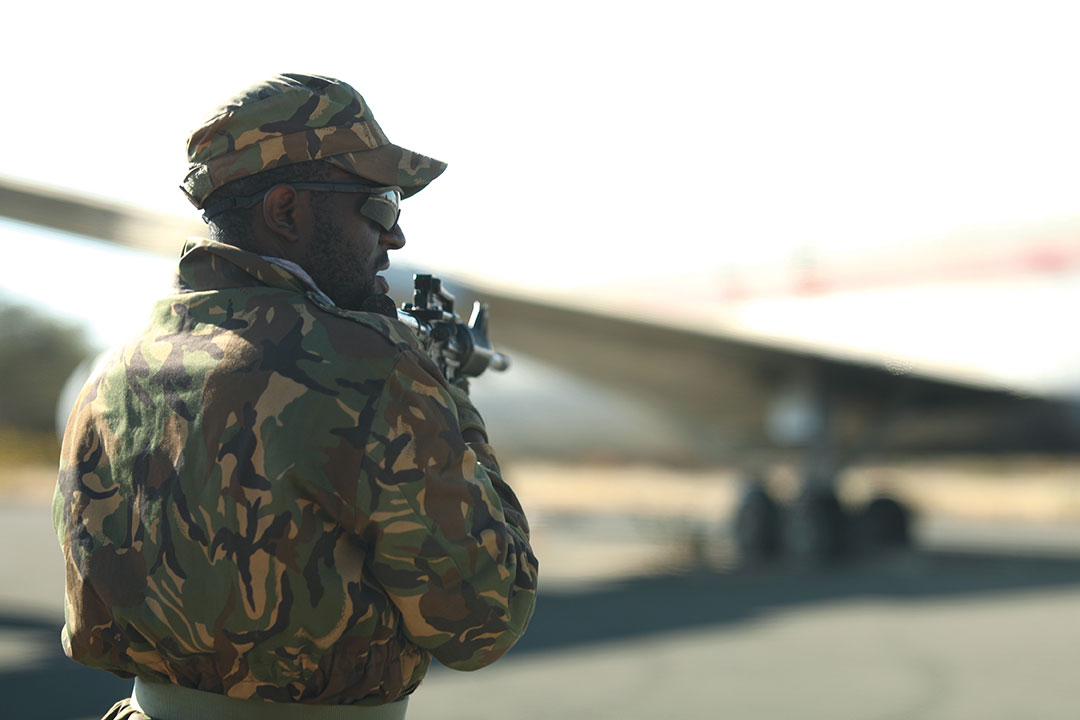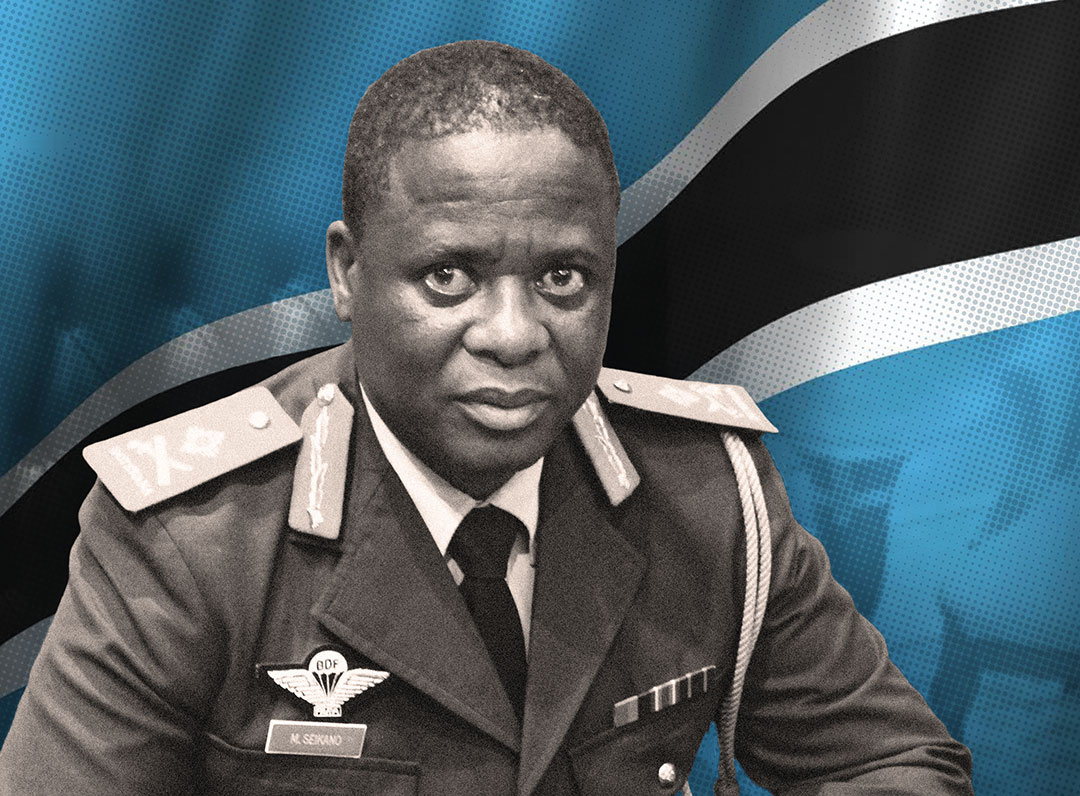‘To Satisfy our Customers’
Maj. Gen. Molefi Seikano of Botswana Says the Military’s Relevance Is Tied to the Satisfaction of the People it Serves
ADF STAFF
Maj. Gen. Molefi Seikano is commander of Ground Forces Command for the Botswana Defence Force (BDF). He joined the BDF in 1985 and volunteered for the special forces unit, in which he held numerous positions. In June 2015, he was appointed commander of Ground Forces Command. Seikano spoke to ADF after the close of the Africa Land Forces Summit in Gaborone, Botswana, on June 27, 2019. The interview has been edited to fit this format.
ADF: Please briefly summarize your service in the BDF, highlighting some of your favorite deployments before becoming commander of BDF Ground Forces Command.
SEIKANO: I joined the military on the 22nd of August 1985 as an officer cadet. Then, when we were in the last leg of our cadet training, I volunteered to join the special forces unit. I started in special forces from 1986 until 2007. And I went through almost all the appointments in special forces, such as troop commander, team commander, the commando unit commander, and at one point the special forces group commander. In 2008, I was promoted to the rank of colonel, and then I was appointed the deputy commander of 1 Brigade Group. I accepted the deputy brigade commander, and I was ultimately appointed the brigade commander of the same brigade group. Thereafter, I was transferred to the northern part of Botswana, where 2 Brigade Group is, and I was appointed 2 Brigade Group commander. From there, I served in special operations in the northern part of the country as the 2 Brigade Group commander. And after that I was appointed commander, Ground Forces Command, on the first of June 2015.

ADF: What made you want to make a career out of military service?
SEIKANO: It all started in 1978 or ’79. The Botswana Defence Force band came to my village. Word just spread fast like wildfire, and I happened to be one of those who was at that age to hear about it and also to follow them around the village as they were performing and walking about. They ended up at the main kgotla [a village center where public meetings are held and the chief addresses his subjects]. From that day on, I knew without any flinching that this is where I am going. I made that determination from that day, even when I was going through my studies in secondary education, I knew that when the time comes for me to decide on my career, I’m going to join the military. I had that feeling to be one of the people who can sacrifice to defend this nation. To me, I wanted to be the best of the best and be prepared to fight for my country, defend my country.
ADF: Botswana has the good fortune to be a nation at peace internally and with its neighbors. Given that, what is the greatest challenge to the BDF right now?
SEIKANO: The greatest challenge right now is to satisfy our customers in the operations they task us to do. Because the military can only remain relevant if the customers, the people who created it, are happy with its delivery in operations or an assignment that it is tasked to do. So right now we are mainly engaged in border operations and anti-poaching operations. We are doing that, but there is a challenge because we have foreign nationals who cross into Botswana as poachers, and those who cross as undocumented immigrants because of the weak capacity of some of our neighboring states. Some of their members cross into Botswana because they look at Botswana as the promised land where they can live below the radar so that they can get some jobs or do something for a living. But the challenge is most of the neighboring states are still struggling or lacking in capacity to really effectively police their side of the borders. And where the countries really cannot police their side of the borders, then it means the poachers themselves will come in, because Botswana holds one-third of the African elephant population and big cats and other species. In our neighboring states, one of our former commanders once invited other armed forces commanders for a meeting so that he could have a platform to try to convince them to involve their militaries in anti-poaching.
ADF: Over the past 25 years, the BDF has assisted local authorities during natural disasters, primarily floods. How does the BDF maintain readiness to respond to floods and other natural disasters?
SEIKANO: The BDF is part of the national disaster management. We have our deputy commander who sits in the national disaster management committee. When he sits there, it helps us to know how the nation wants to address issues of disaster. But as you go down that structure, we have the district offices chaired by the district commissioner. The district commissioners work with the brigade group commanders. And it is there that they plan how to deal with the disasters that are likely to happen or that are prevalent at certain times of the year. Because some disasters are seasonal. Like floods will come after heavy rains. Wildfires will occur when the terrain gets dry in the summer season. In addition to that, when it comes to the issue of training last year [2018] we conducted a national disaster management course at our peace training center. In our peace training center, some modules were developed that can bring all the stakeholders together who are usually involved when the disaster strikes. So they went to the CAX exercises — computer-assisted exercise — in that peace training center. It is our intention to keep on influencing that such exercises are done. We can then take that plan and try it out in a field exercise, a simulation exercise.
ADF: The BDF also assists the Department of Wildlife and National Parks to combat poaching. In what ways does the BDF assist with or perform anti-poaching efforts? And how successful have those efforts been to date?
SEIKANO: The management of wildlife in national parks is the responsibility of the Ministry of Environment, Wildlife and Tourism. But the BDF has been given the primary role of anti-poaching. We deploy joint task forces as the BDF in three of the BDF operational areas for border and anti-poaching operations. Because, first and foremost, our mandate is to defend our territorial integrity. We specifically have two brigadiers today who have served as national anti-poaching coordinators. In the past we’ve also had some officers assigned as BDF anti-poaching coordinators, and the current director of wildlife is one officer. I also served as a BDF anti-poaching coordinator. Now we have anti-poaching coordinators at the national level. So what efforts did this bring? The national coordinators, even the BDF coordinators at the time, they were coordinating anti-poaching activities and ensuring that they promoted information sharing between the communities on matters of poaching. Right now at this level where we have the brigadiers as anti-poaching coordinators, they coordinate a broader interagency spectrum. They are responsible for interagency coordination to fight poaching. And this is in line with our SADC LEAP [Southern African Development Community Law Enforcement and Anti-Poaching] Strategy, and the draft national anti-poaching strategy that poaching needs a whole-of-government approach.
ADF: Earlier in 2019, the BDF successfully passed an inspection by the SADC specialist team to confirm that capabilities pledged by the BDF were available and ready to participate in peace support efforts. Talk a little about how the BDF achieved this readiness for Standby Force duties.
SEIKANO: We first participated in an exercise in Malawi. The brigade commander and his staff went for that exercise; it was a command post exercise. Over and above that, we managed to refurbish some of our equipment, including the ACMAT [tactical military] vehicles in our local vehicle service providers. Similarly, we ensured that we have the necessary Soldier protection material for the troops. We issued it to all the Soldiers who have been assigned for the task. And by, of course — an important point — conducting regular inspections prior to the main inspection to see that those inspections are to my satisfaction. So inspections, inspections, inspections, inspections until people know what is really expected, and it becomes part of them.
ADF: What would be your advice to other SADC countries seeking to prepare for and pass that Standby Force inspection?
SEIKANO: As the defense chiefs embraced the fact that SADC had reached the full operational capability after the report of Exercise Amani Africa II, what it meant is that the right thing to do was that all the defense chiefs should have started or should start preparing to meet the requirement of their forces so that they can contribute the required capabilities toward the SADC Standby Force. So what I can say here is that since we have declared the SADC at full operational capability, then they must make sure that they prepared their forces and try to acquire the necessary Soldier protection material and equipment and other needed equipment that may be required, given Scenario 6, which talks to rapid deployment capability of the Standby Force. That’s what we should be doing, and that’s what all SADC members should be doing.
ADF: How important are events such as the Africa Land Forces Summit in adequately preparing Botswana and its regional neighbors for the range of transnational criminal and security challenges it is likely to face?
SEIKANO: It helps Botswana to enhance cooperation with its neighbors, develop new areas of cooperation with its neighbors, and promote trust among ourselves as neighbors. When we are connected, and trust each other, we can better address issues of our subregional challenges. We can better address the issues of interoperability. We can better engage and through that enduring engagement as neighbors, address issues of doctrine, talk to the issue of training and materiel for our training operations, and even realize how we can share some of the facilities that some of these countries offer, and even our training areas. You’ll find that we have the desert here. And you may find that in Zambia they have a different terrain, which you don’t have here. In South Africa they have the sea. So we can even consider maybe training our forces in some of these terrains. These can be some of the innovations that come out of these partnerships. Above all, the summit enables Botswana to really have an in-depth understanding of the core issues of some of our neighbors and how they are addressing those.


Comments are closed.